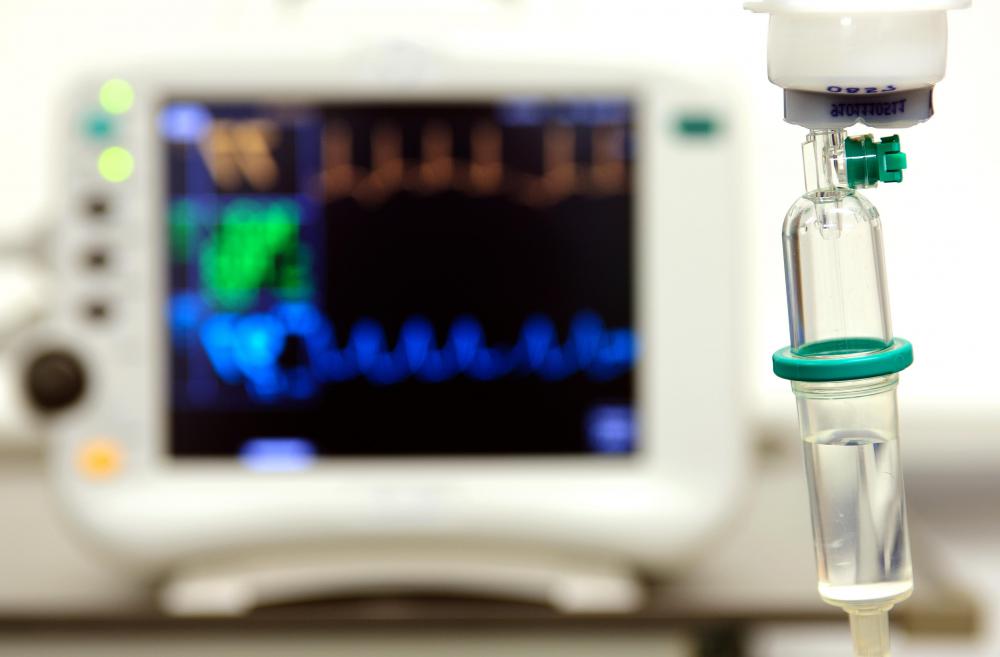At TheHealthBoard, we're committed to delivering accurate, trustworthy information. Our expert-authored content is rigorously fact-checked and sourced from credible authorities. Discover how we uphold the highest standards in providing you with reliable knowledge.
What is a Bolus Injection?
When a doctor needs to quickly increase the blood concentration levels of a medication in a patient's system, the patient may be administered a bolus, the injection of a large quantity of a particular medication or medications. A bolus injection increases the concentration of a drug in the blood stream so the drug can start working quickly. Such an injection is often followed by a slower-acting intravenous drip line so medicine can continue to be administered over a period of time. Intravenous, intramuscular, intrathecal and subcutaneous bolus injections are all available.
Standard vaccines are given intramuscularly using a bolus method. By injecting the bolus directly into the muscles, the body has time to absorb the vaccine and create antibodies to encourage the immune system. Other types of injections that are given intramuscularly include pain medicine, and testosterone and birth control hormones. Intramuscular bolus medication is often given in the upper arm or upper thigh areas, because of their large muscle mass and ability to spread the medication through the muscle surface.

Intravenous bolus injections go directly into the veins via an intravenous line (IV). The bolus injection often serves as a precursor to a longer-term IV drip of a medication. Through intravenous injection, the medication quickly arrives in the blood stream at the desired concentration levels. Antibiotics and chemotherapy medications are commonly administered first with a bolus of the medication and then with a drip of the medication over a longer period of time. An initial antibiotic bolus injection allows doctors to decrease fevers quickly and control an infection before administering the complete antibiotic series.

Another slow-moving release method for a bolus injection is the subcutaneous type. Subcutaneous bolus injections move slowly through the tissue of the body, offering long-term benefits to patients. Drug addicts receive medication this way during inpatient treatment stays, especially when past drug use has made their veins difficult to use for medication purposes. Insulin and morphine can also be administered subcutaneously.

Intrathecal bolus injection is the act of injecting a medication directly into the arachnoid membrane of the spinal cord. Anesthesia used during childbirth is often given in this manner. Pain management medication and chemotherapy can also be given using the intrathecal bolus method.
Where a bolus injection is given depends on the needs of the patient and the desired speed of the medication's effectiveness. The concentrated dosage of a bolus injection is invaluable in emergency medicine, as well in treatment for illnesses such as diabetes and cancer. Bolus injections allow medication to become useful to a patient faster, which can be the difference between life and death in some situations.
AS FEATURED ON:
AS FEATURED ON:















Discussion Comments
@angelBraids - If your mom read it in that kind of novel it could have been related to a death row execution.
Typically, those who die from lethal injection receive three bolus injections of different drugs. They are administered intravenously for quick effect of course.
I've been trying to define a bolus injection since my mother asked me about it last month. She saw the term in a crime novel and thought it might be something related to illegal drugs! Thanks for helping me to put her straight on this.
I used to be a nurse and so I have given a lot of injections in my time. I remember that many patients were scared of intramuscular jabs because they can be painful.
We were taught a technique in nursing school that helped find the best place, when administrating a bolus injection to the buttock area. But like most things, some of us were better at it than others.
In case you're curious, the method involves drawing two lines on the body with your finger and aiming for the cross point. Often this alone was enough to distract the patient so they didn't even realize you'd given them the needle.
Post your comments